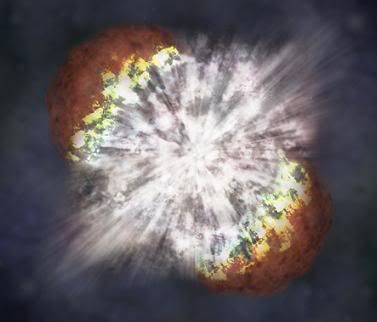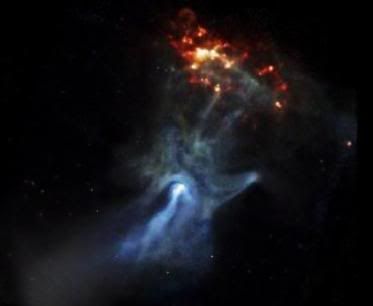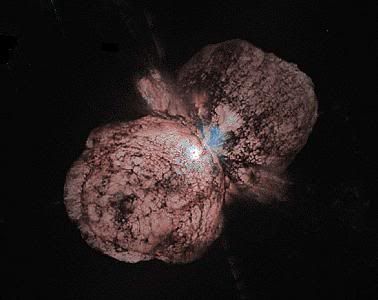Post by glactus on Oct 13, 2011 1:54:17 GMT
A star 100-200 times more massive than our own sun went nova in September 2006, making it the biggest supernova in recorded history, according to a new study from the University of California, Berkeley and the University of Texas.

An artist's renderind of supernova SN 2006gy
Not only was it bigger, but it took longer to reach the pinnacle of its brightness and stayed that way for months, and is outshining its host galaxy, NGC 1260, which is 240 million light-years from Earth.

Here the supernova was captured by NASA’s Chandra X-ray Observatory and ground-based optical telescopes.
UC Berkeley post doctoral fellow Nathan Smith said that the discovery of supernova SN 2006gy may revolutionize the understanding of how really massive stars end their life.

The galaxy NG1260
"Instead of just winking away into a black hole, they apparently can suffer these brilliant explosions that can be seen far across the universe. The fact that this thing is so bright, and stayed bright for a long time, makes our chances of detecting them in the early universe much better," he said in a statement.

The doomed star Eta Carinae
Smith’s colleague, Alex Filippenko, an astronomy professor at UC Berkeley, said that another nearby star in the Milky Way Galaxy, Eta Carinae, may go nova in much the same fashion.
"This is also very exciting because it suggests that Eta Carinae, only 7,500 light years away, might possibly explode in a similar manner, becoming a spectacularly bright star in our sky," Filippenko said in a statement.

Credits: These are Chandra x ray images.
Special credits: University of California, Berkeley and the University of Texas.
Text by Wikipedia

An artist's renderind of supernova SN 2006gy
Not only was it bigger, but it took longer to reach the pinnacle of its brightness and stayed that way for months, and is outshining its host galaxy, NGC 1260, which is 240 million light-years from Earth.

Here the supernova was captured by NASA’s Chandra X-ray Observatory and ground-based optical telescopes.
UC Berkeley post doctoral fellow Nathan Smith said that the discovery of supernova SN 2006gy may revolutionize the understanding of how really massive stars end their life.

The galaxy NG1260
"Instead of just winking away into a black hole, they apparently can suffer these brilliant explosions that can be seen far across the universe. The fact that this thing is so bright, and stayed bright for a long time, makes our chances of detecting them in the early universe much better," he said in a statement.

The doomed star Eta Carinae
Smith’s colleague, Alex Filippenko, an astronomy professor at UC Berkeley, said that another nearby star in the Milky Way Galaxy, Eta Carinae, may go nova in much the same fashion.
"This is also very exciting because it suggests that Eta Carinae, only 7,500 light years away, might possibly explode in a similar manner, becoming a spectacularly bright star in our sky," Filippenko said in a statement.
Credits: These are Chandra x ray images.
Special credits: University of California, Berkeley and the University of Texas.
Text by Wikipedia


